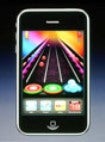On Friday Apple  released a letter admitting the iPhone 4 has problems, but insisted they are due to a signal-strength formula that is "totally wrong" and not caused by the antenna design. Since then the news has saturated tech blogs, Apple support sites and message boards -- and it seems like most people aren't buying Apple
released a letter admitting the iPhone 4 has problems, but insisted they are due to a signal-strength formula that is "totally wrong" and not caused by the antenna design. Since then the news has saturated tech blogs, Apple support sites and message boards -- and it seems like most people aren't buying Apple 's explanation.
's explanation.
Apple says the erroneous formula displays more bars than it should and that the sudden drop some users see when gripping the phone in a certain way is the because the "high bars were never real in the first place."
Stevesst wrote in response to the letter on Apple's iPhone 4 support forum, "Sooooo, Im having a hard time finding the connection with how it calculates bars and the way people hold their phone and dropping bars."
Quite a few commentors shared the writer's confusion, especially since Apple says the formula has been in play since the first-generation iPhone .
.
Steviejobz (I'm guessing no relation) even went as far to say, "I love how Apple thinks its customers are idiots. So we are to believe that Apple has not figured this out after 4 years of making a handset?"
While the iPhone's reception display may be misleading, most people (with a few exceptions) seem to think that fixing that isn't going to address the death-grip dropped calls.
Sneezymarble, a commentor on macrumors, wrote, "Surprisingly, no matter how I hold my iPhone 3G at my house it never completely loses signal and I'm always able to make calls. But, if I place my pinky finger over the little black strip on the bottom left side of my iPhone 4, my signal drops and I can't make any calls. That, Apple, has nothing to do with the number of bars being displayed."
A lot of people are "lol"-ing at Apple's response and accusing the company of diverting the issue.
PC World commentor jntowers said, "The original YouTube videos showed bars not only dropping, but calls actually being dropped. Unless the call connection is based on what the software is showing for signal strength, I find all of this very hard to believe and it feels simply like a cover up."
Others say there is some credibility to Apple's explanation.
Brian Klug and Anand Lal Shimpi over at AnandTech suggest that holding any smartphone in this manner can result in a measurable loss in cellular reception, described in their iPhone 4 review. They did find that the iPhone 4 was particularly prone to losing signal.
review. They did find that the iPhone 4 was particularly prone to losing signal.
"The drop in signal from holding the (iPhone 4) with your left hand arguably remains a problem. Changing the bars visualization may indeed help mask it, and to be fair the phone works fine all the way down to --113 dBm, but it will persist -- software updates can change physics as much as they can change hardware design. At the end of the day, Apple should add an insulative coating to the stainless steel band, or subsidize bumper cases. It's that simple."
To Apple 's credit, some people are relieved that the company is at least acknowledging that something is going on with the newest smartphone. A few iPhone 4 owners are even coming to Apple's defense.
's credit, some people are relieved that the company is at least acknowledging that something is going on with the newest smartphone. A few iPhone 4 owners are even coming to Apple's defense.
My PC World colleague Mike Keller said, "For the record, I have never experienced the bar dropping phenomenon (on the iPhone 4 ) and call quality and reception is far better than on my 3G . . ."
) and call quality and reception is far better than on my 3G . . ."
Apple still stands behind its statement that the iPhone 4's antenna is "the best we have ever shipped." It will adopt AT&T 's recommended formula in an upcoming update to make the graphic a more accurate representation (or perhaps to pass the reception complaints over to AT&T's support line.)
's recommended formula in an upcoming update to make the graphic a more accurate representation (or perhaps to pass the reception complaints over to AT&T's support line.)


Comments
Post a Comment